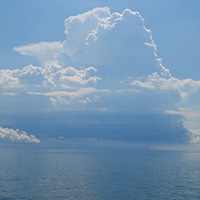For reasons presumably lost to history, Milwaukee – despite its Italian communities in the Third Ward, Bay View, West Allis and around Brady Street – was slow to the pizza party.
While it's long been said that Gennaro Lombardi brought his Neapolitan-style pizza to the United States when he transformed his Little Italy grocery store into America’s first pizzeria in New York City in 1905, that turns out not to be true, as Filippo Milone had multiple pizzerias in New York City (even opening the one on Spring Street that Lombardi would later run) before Lombardi even came to America.
Believe it or not, Milwaukee’s first pizza restaurant wouldn’t open until 1945, and it didn’t start out serving pizza.
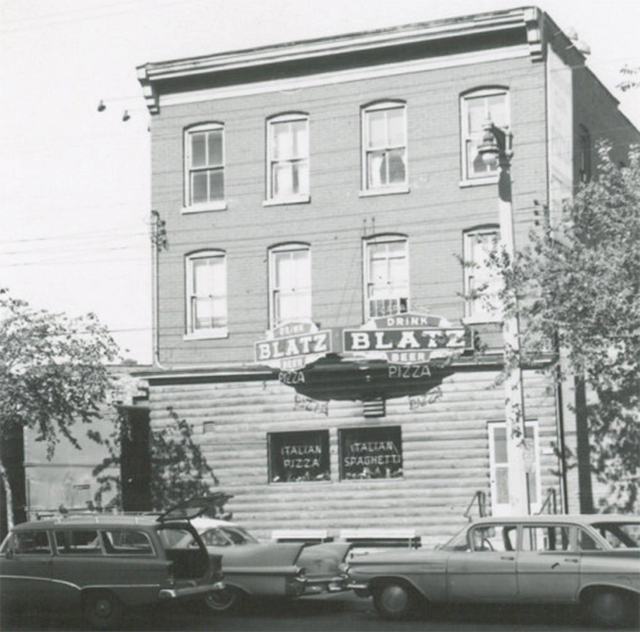

John Caravella – born in Milwaukee in 1905 to immigrant parents from Naples – and Joe Todaro – himself a Sicilian immigrant – opened the Caradaro Club at 326 E. Erie St. on the ground floor of a three-story building at 326 E. Erie St., below a boarding house in 1945. That’s two years after Pizzeria Uno owner Ike Sewell and/or – depending on who you believe – Uno chef Rudy Malnati invented Chicago’s deep dish version at the restaurant in the Windy City’s River North neighborhood.
And Italian food and wine merchant Anthony Paterno – a Sicilian immigrant who stopped first in Brooklyn before heading west – opened what’s believed to be Chicago’s first pizzeria – pictured below – on Grand and Western Avenues even earlier than that, in 1938.
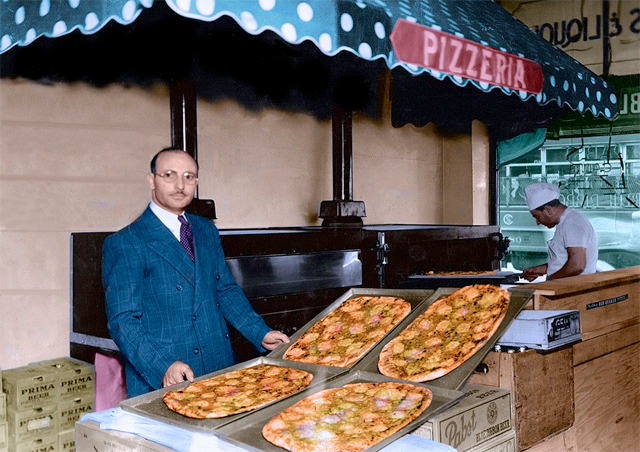

Previously, the Caradaro building had been home to Yugoslavian immigrant Anton Glazer and his family. During Prohibition Glazer operated a soft drinks parlor on the ground floor, converting it to a tavern in '33 after the alcohol ban was repealed. For a couple years in the '30s, Frank and Elsie Manson ran the Seamen's Inn before taking over a tavern on 16th and Canal.
Glazer, who still owned the building, took back the bar and ran it with his wife Anna. The family – the Glazers, their three children, a son-in-law and granddaughter – lived in the second floor apartment, and rented the third floor rooms to six lodgers.
Entering the place, the bar ran along the west wall. The kitchen was in the back on the left and a small back room was on the right in the back. This arrangement endured when just a few years later, Todaro and Caravella – who was a relative of Todaro’s wife, Agatha – opened the pizzeria despite having roots as working men not restaurateurs.

The early years
"(My dad) was born in Sicily in 1908," says Frank Todaro. "My grandfather made four trips from Sicily to America, and on the fourth trip, when my father was 15, he took him along. He stayed for a couple of years, and I think my father was like 17 and my grandfather said, ‘well, I’m gonna go back to Sicily,’ and my father said he’d like to stay in America, and so he did."
In 1933, when he was 24 and working as an elevator operator, Todaro married 19-year-old Agatha Patti, who had a job as a sales clerk.
Todaro joined the Army in the 1930s and was stationed in Hawaii at Schofield Barracks, near Pearl Harbor. During this time, his son recalls, Joe was a boxer. The elder Todaro became a citizen in January 1938, and Frank was born the following year.
Back in Milwaukee, Todaro first shoveled sand in steel foundries and then learned to work as a molder in those ungodly hot places. At the same time, Caravella was a laborer in a paper factory. A decade earlier, he’d been a welder in a machine shop.
"Well, then the war came," says Frank Todaro, "(Dad) became a foreman and then he got a job offer in Detroit at Michigan Steel to be a night superintendent. (He) spent all the war years in Detroit working, and then after the war, we came back to Milwaukee because my mother missed her family and wanted to go back to Milwaukee – back to the Italian Third Ward neighborhood."
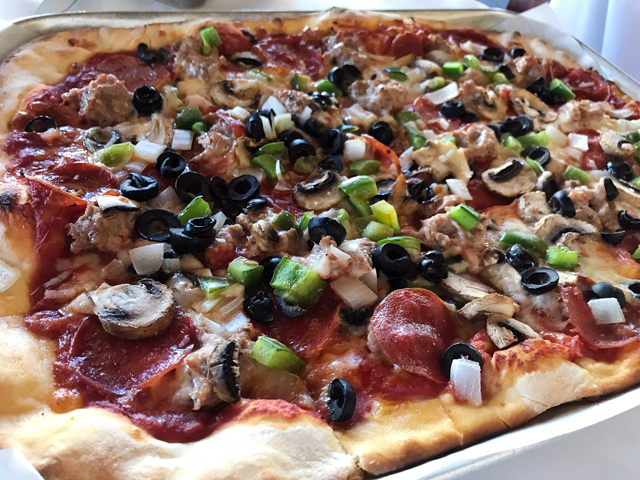

There, Joe Todaro knew he needed to do something, but, says Frank, he wasn’t quite sure what.
"They had a friend that had a bar and (my dad) helped him tend bar, and he enjoyed it. He was a gregarious type of a guy. Dealing with people suited him, and he saw that maybe the tavern business was a good way to make some money."
So, Todaro and Caravella went into business together, buying Anton Glazer’s tavern and boarding house on Erie Street, where Frank Todaro grew up and which he remembers well.
"I’m not really sure when exactly it was built, but I think it was around the Civil War years," Frank says, "1860-something. It was a three-story brick building. There was a bar and a restaurant on the bottom and then 13 rooms on two floors above that, and it was like a rooming house especially for Great Lakes sailors. We were only a block away from where the old Milwaukee Clipper used to be. Right across the street from the Milwaukee River and just a few blocks from Lake Michigan itself.
"We moved in on the second floor when I was about 6, 7 years old, and that’s where I lived most of my life in Milwaukee. I always called it the Italian penthouse.
"It was an interesting upbringing because. … there were about five or six old guys, derelicts mostly, that lived upstairs. My father didn’t have the heart to throw any of them out. They lived there, and I remember one guy that sailed on sailing ships. He was 70-some years old, and he had sailed the Great Lakes on sailing ships."
An early listing in a Milwaukee City Directory refers to the business as Caravella & Todaro Tavern. But that partnership would prove short-lived, according to Frank Todaro.
"He figured he wasn’t suited for the restaurant business. It didn’t take him too long; it was like six months (in). They parted friends and stuff. It didn’t suit him … it’s a lot of work (running a restaurant)."
Todaro knows first-hand how much work Caradaro Club demanded, because he worked there nearly his entire life, up until it was sold.
"It was a family-run business," he says. "We didn’t hire any strangers; it was almost all family. Everybody in the family legally had a bartender’s license. I was 10 years old and on Sunday mornings, especially, my father would be real busy but we had the regular guys that were just sitting around drinking a beer or two. I tended bar when I was 10 years old."
Caravella’s time at Caradaro may have actually lasted a little longer than a few months. His name continued to appear in City Directory listings for the restaurant through at least 1947. By ‘49, however, he no longer appears to be connected and is listed, generically, as a "driver" and, a year later, as a contractor.
It’s also possible his departure was due to something other than a disinterest in the restaurant and tavern business, because by 1952 – like it or not – Caravella was back in that world, running Doc’s Coal Hollow Tavern, at 6th and Canal Streets in the Menomonee Valley. The short-lived place ran afoul with authorities, who called it "a hangout for hoodlums and holdup men," and declared it "insanitary (sic) and unfit for any occupancy or use."
The tavern was owned by the Union Transfer Co., but was run by "John J. (Doc Bones) Caravella," who, according to the Milwaukee Journal, had been arrested during Prohibition after a car he was riding in was stopped and found to be carrying two gallons of moonshine (a 60-gallon still, 200 gallons of mash and another 20 gallons of moonshine were found in his Astor Street house). In 1954, Caravella, the paper reported, "had been charged with receiving part of $4,700 stolen from a Kohl’s food store manager."
Though those charges had been dismissed a few months later, the Milwaukee Police Department appeared before the Common Council urging the body to revoke the tavern’s liquor license. That testimony was likely successful because, by 1956, not only does Doc’s Coal Hollow disappear from the record, so does its address, suggesting the building was razed.
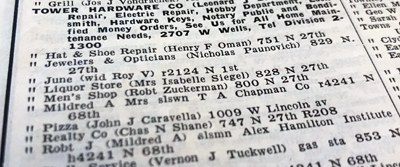

Caravella went to work briefly as a welder, but soon returned again to the restaurant business, working first at DeCarasil Restaurant – near his home at 29th and Forest Home Avenue – for a couple years, before opening Tower Pizza, at 1009 W. Lincoln Ave., in 1958 or ‘59. When it closed in 1961, Caravella retired.
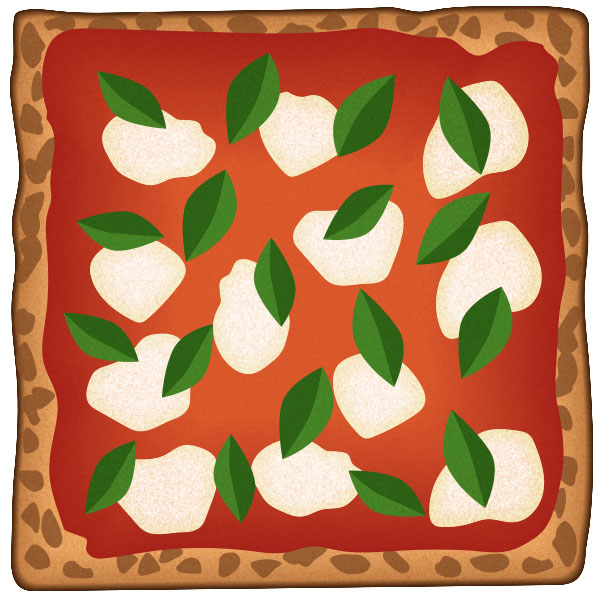
What’s pizza?
When Caradaro Club opened in 1945, lasagna and other Italian-American dishes were served, but pizza was not. Nor was it even on the radar.
"My mother, she was a good cook," says Frank Todaro. "So they made lasagna and spaghetti and meatballs, and steaks and chops."
Todaro says that at this point, pizza – which he says many mispronounced – was unfamiliar to most Milwaukeeans.
Unfamiliar, perhaps, but not completely unknown. A 1935 recipe column in the Journal noted, "An Italian dish called ‘Pizzarole Neapolitine’ (Ed: which is more like a calzone than a pizza) is the request of a reader. It has a dough base with a filling of tomatoes, shrimp and anchovy among other things. Can any reader supply the recipe for this dish?"
Readers would have to wait a couple years to find a recipe for something similar.
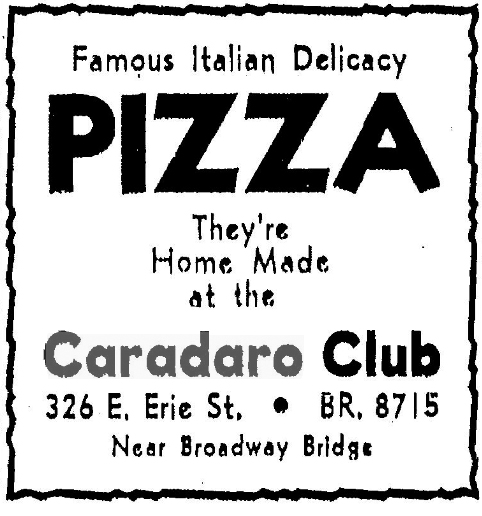

In a 1937 article about Christmas breads, Jean Templeton wrote in the Milwaukee Journal, "The day before Christmas is a fast day for Italian families, so they make a bread named pizza. Mrs. Joseph D. Frinzi, Milwaukee, gives us her directions for the Italian bread."
A recipe followed for dough that would then be "spread into a shallow pan or deep baking sheet. … Over the top sprinkle chopped tomatoes … anchovies, onions and grated Romano cheese."
Two months earlier, in an interview, comedian Milton Berle spoke of his love for pizza, which was reported without explanation, suggesting most readers might already be familiar with it.
In fact, the early years of television and Berle, in particular, helped bring pizza to Milwaukee, according to Frank Todaro.
"Television started to be popular, and Milton Berle came on and they started talking about, ‘oh after the show, let’s go and have a pizza.’People in Milwaukee were going, ‘what’s a pizza?’ There wasn’t any. (Caradaro) happened to be right across the street from Taylor Electric (on Jackson Street), and Taylor Electric was the RCA distributor for all of Wisconsin. Mr. Taylor used to come in for lunch and one time he said to my father, ‘Hey Joe, if I give you a television set, would you put it up there?’ He thought it would be good marketing. And so they did put this television up there. And now more and more they were watching TV and every once in a while pizza was mentioned. So my father started thinking maybe they should look into it."
To learn more about this pizza thing, Joe and Agatha Todaro turned to an expert: Chicago pizza pioneer Tony Paterno, who they knew from his business selling Italian foods not only in the Windy City, but also up here in Milwaukee. Paterno was an importer of Italian foods and olive oils and in 1946, the year after Caradaro began making pizza, he bought Pacific Wine Company, which bottled California-made wines under a variety of different labels.
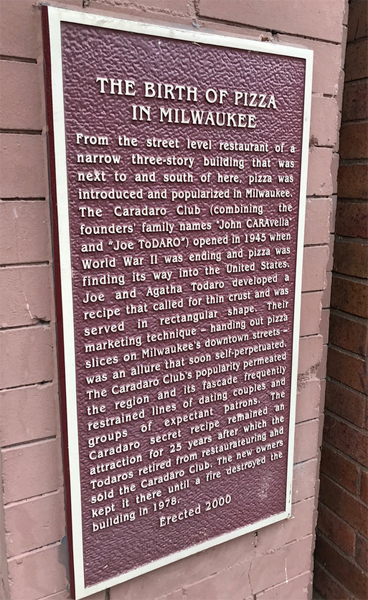

"Tony Paterno used to come to Milwaukee with an old truck loaded down with fruits and vegetables and sell them in the Italian neighborhood," Frank Todaro recalls. "And so my father kind of knew him. My father, mother and I – I was just a kid; I was 7 years old – went with them down there, and my dad just looked the place over, saw how the pizza ovens were and this and that.
"My dad says, ‘So what do you put in the dough?’ Tony Paterno wouldn’t tell him. My father bought a couple used ovens and put them in the kitchen, and then my mother started to experiment with a pizza dough that would be tasty and crispy. And they came up with a good recipe."
Gino Fazzari – who owns Calderone Club and Pizzeria San Giorgio and whose father Antonio later bought the Caradaro Club from Joe Todaro – recalls the products used to create the early pizzas, made, says Frank Todaro, in a pair of Blodgett gas ovens.
"They used to use the Bravo or Lindsay (brand) California sliced black olives," he says. "They used to use Bonta Pizza Sauce – which is now owned by Escalon – which is a California sauce. They used to use King Arthur Flour."
Todaro remembers, too:
"My father used cake flour because it was finer. It had yeast, and he put baker’s malt into it for the flavor and he used lard and olive oil. The consistency of the crust was a little bit more than crackers but it was flaky and it had a nice flavor. We didn’t make round pizza, they were oblong and you’d cut them into squares. … And sauce (was) crushed tomatoes with, if they put anything in it, salt. You put a little oregano on and mozzarella cheese goes over that. And then on top of the mozzarella cheese, you put toppings, and in those days all we had was pepperoni and sausage, olives, mushrooms and onions. The guy … that was making the sausage for us, he used pork butts (and) my father was very particular about how much fat was in them. It was good. The best Italian sausage I’ve ever tasted came from Milwaukee."
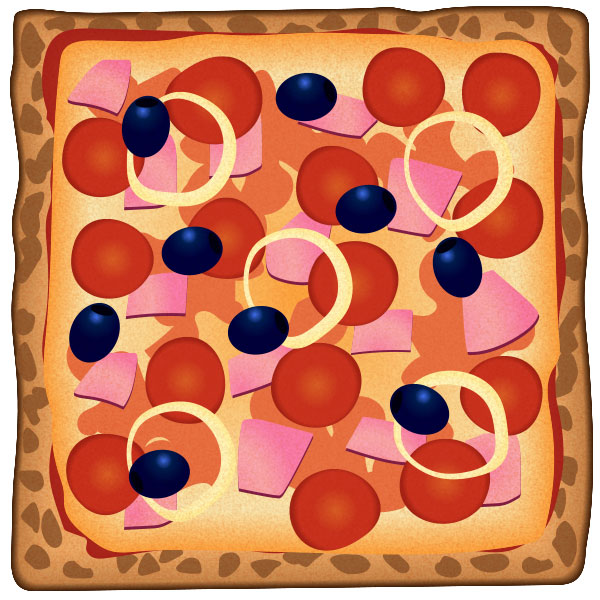
Pizza makes a splash
Whatever the reason for the delayed arrival (to be fair, St. Louis and Detroit got their first pizzerie in 1945 and ‘46, respectively, too), Caradaro Club opened and quickly became popular. While Agatha Todaro worked at perfecting the recipe, she and Joe didn’t sell their pizza, but gave it away to patrons and, according to some sources, out on the street.
"My mother and dad would come out to their regular customers and they’d offer it to them, ‘here try this,’" says Frank Todaro. "‘What is it?’ ‘Well, it’s pizza.’ Everybody was calling it ‘pissa pie’or something like that. It took them maybe six months before they started to actually sell it.
"Within a year or two people were standing in line to come in for pizza. I remember my mother looking out at the line of people outdoors and she was crying and my father said, ‘what are you crying about?’ She said, ‘we can’t take care of all these people.’ My father said, ‘don’t cry, that’s a good thing.’"
In the early days, it wasn't as hard to fill the place, which the year before the Todaros bought it had a capacity of 45 patrons – 25 in the back room, 10 at the bar and 10 at tables in the tavern room. By the mid-1960s, changes had upped that to 100.


Other early Milwaukee pizza pioneers quickly appeared, including Joe Dentice and John Alioto whose Express Bar & Restaurant at 800 E. Michigan St. advertised pizza – "it's new, come in and try it. N.Y. style" – in mid-December 1945.
The Latin Quarter at 333 N. 7th St., advertised its Friday special in April 1946, less than six months after it opened:
"Hot Pizza Pie … That famous dish served at the best Italian restaurants in New York and Chicago is now featured every Friday by Mrs. Bon at the Latin Quarter. Try it with a bottle of our imported Chianti wine … a decided taste thrill you’ll want to repeat."
Dibella, 819 E. Brady St., was doing pizza in ‘46, too. "We invite you to try the new taste thrill Italian baked delicacy, pizza," it boasted in one newspaper ad. Another ad followed explaining the pronunciation – peetza – and noted that "one dollar serves four."
In 1949, Chicago-style pizza arrived in Milwaukee via Pete’s Pizzaria (sic), on 27th Street and Fond du Lac Avenue, which stayed open until 5 a.m., and served "Genuine Pizza, Chicago Style," according to an advertisement.
"It’s crispy! It’s tasty! The restaurant with the greatest Pizza reputation in Milwaukee – where people who care for Pizza meet."
Vince DeMarini opened his place on Wentworth and Potter in Bay View in 1952, and Zaffiro’s would land on Farwell Avenue in 1954. Lisa’s on Oakland dates to 1960, to name but a few that would come later.
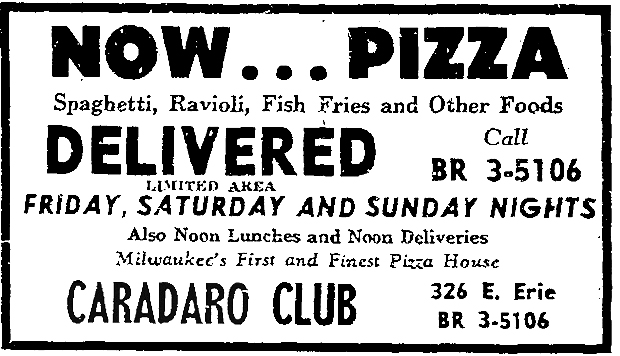

In the ‘50s, pizza had exploded in the Third Ward, where you could get it not only at Caradaro Club, but also The Italian Village, La Tosca Cafe and other restaurants.
In ‘51, Joe Todaro expanded the kitchen by building a small addition onto the back of the Caradaro, which continued to rent out the rooms on the third floor until around the end of the 1950s.
"For years in the late 1940s and early 1950s, this joint of humble demeanor held a virtual monopoly on pizza," Gerald Kloss wrote, errantly, in the Milwaukee Journal in 1973.
"‘Those were the days, all right,’ said Rosie, a veteran waitress at the Caradaro. ‘On Saturday nights, people waited in line for their pizzas. Young men, trying to impress their dates with a new thing to eat, introduced them to pizza. It was something, you know? Here was something you had to pick up with your hand to eat. No knife. No fork. What a delight!’"
Milwaukee attorney and former Italian Community Center president Bill Jennaro – whose roots are in Sicily – was best friends with Frank Todaro, who he credits with introducing him to pizza.
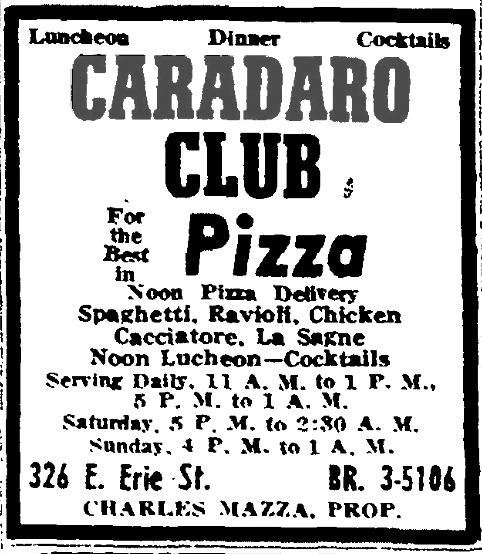

"I didn’t even know what pizza was when I met Frank in 1954," Jennaro recalls. "He said, ‘come on down, you’ve got to try it. There was a waitress who waited on us and she was the nicest lady. It was Jimmy Balistreri’s mother. Jimmy worked in the kitchen. He was just learning the business then.
"I had this pizza and I went home and told my mother, ‘I tried this pizza and it’s a lot like the sfinciuni you make at Christmas, but better.’ She said, ‘fine, go have that instead, then.’ And I said, ‘no, no, Ma, yours is better, but I liked it a lot.
"That’s when I first learned to be a mediator," Jennaro laughs.
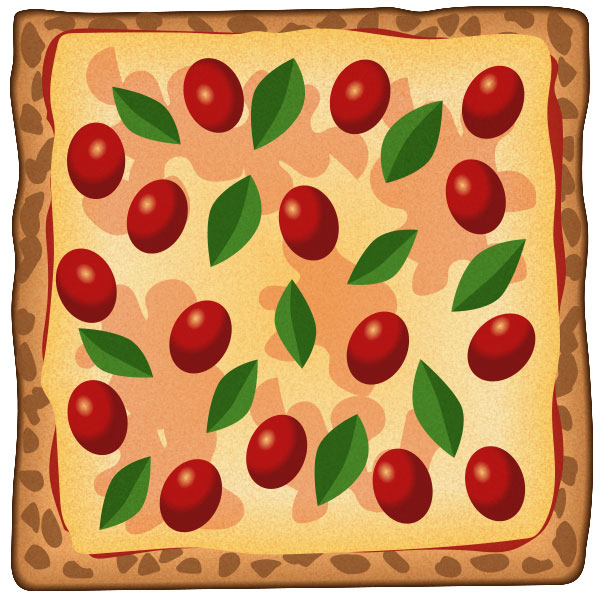
Paying it forward
In 1948, Todaro returned to his native Santo Stefano di Camastra for the first time since he was 15 years old, and he took his family with him, says Frank Todaro.
"Because the pizza business blew up into something way beyond their wildest dreams, he had more money than he had ever been used to. Now, it was over 25 years since he had seen anybody in his family. He saw all of his old friends that he had grown up with. The town was built on a mountain that was almost all clay – the great ceramic clay. To get it, there would be a guy (who) just took a small little tool and started chopping away at the clay and then putting it in a basket and then the kids would scurry down into these holes and grab the baskets and run out and pour it into a bigger basket that was on top of a mule. And then they would mix the clay up with water and stuff and there would be guys that were making tiles and roofing and everything else.
According to Todaro, his father returned to Sicily in 1957 – where he spent six months – and it was at that time that he had the idea of building a factory.
"My dad wanted to do something for his town. That’s the kind of guy he was. He started negotiating back and forth … and by 1960 he had settled it. My father built the factory with the long automated furnaces and (later) a bulldozer that would get large amounts of clay out without anybody having to go down into holes. In essence the town economy rose."
In his native town Joe Todaro was known as "u miricanu," which is Sicilian for "the American," says Tiziana Orifici of Santo Stefano’s MUDIS – Museo della Ceramica, housed in the town’s historic Piazza Trabia.
"When he came back to Sicily, he started a company to build – between 1960 and 1962 – the Stabilimento Laterizi Stefanesi in S.Stefano di Camastra," says Orifici, "where clay was available and dug from the nearby hills using the technique of tunnels up to 10 meters long, as high as a man and just wide enough to dig and carry out the clay in woven baskets."
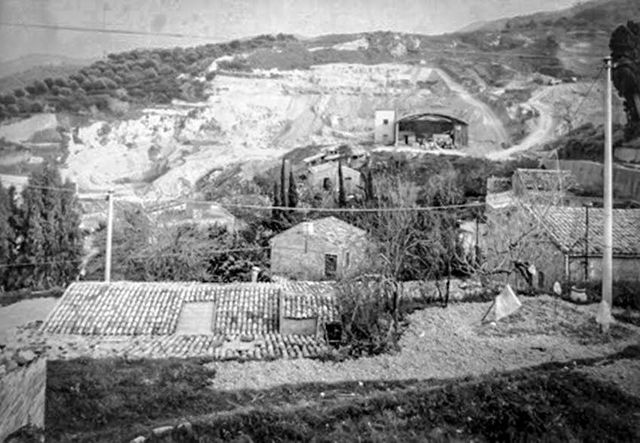

Orifici says the factory made bricks from the clay and it closed in 1968, "for lack of funding/economic problems of the three partners."
Later, in the early 1970s, she says, it was reopened as a cooperative without Joe Todaro’s involvement. The factory was shuttered again around 1984 and torn down. "As far as I know," she says, "Joe Todaro went back to the USA after the company’s failure."
Frank Todaro remembers at least one more visit after the closing of the Stabilmento Laterizi Stefanesi.
"In 1974 was the last time I went back with my father," he says. "My father gave me $50 in Italian money, and we were having a wonderful time. … He asked me after about a week or two he said, ‘do you need any money?’ And I said, ‘no, I still have the money you gave me.’ And he goes, ‘how’s that?’ I said, ‘nobody will let me spend any.’ Any place you went, if you went and had a cup of coffee, there were some people that would have liked to erected a statue of my father. He had good fortune and passed it on."
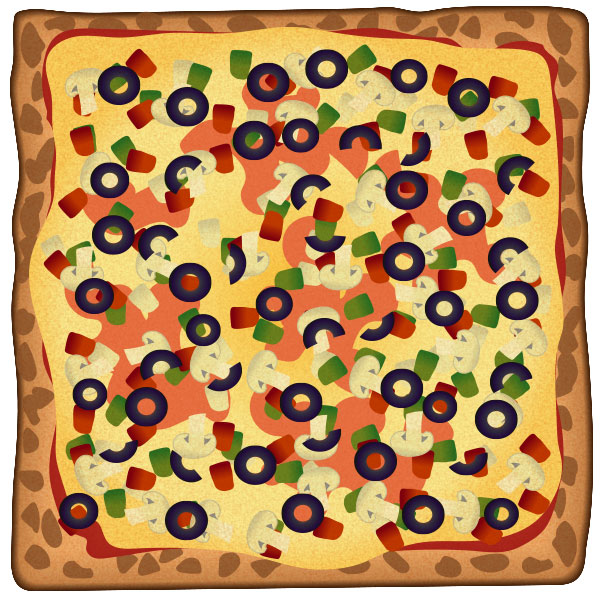
Caradaro carries on
Back in Milwaukee, Todaro had entered into a partnership with his friend Charles Mazza in 1956. Mazza, who had worked as an accountant at Borden Milk, arrived no restaurant experience whatsoever.
"It’s a little confusing," says Charlie Mazza’s son, Chuck. "They went into partnership on the business but not the building. About four years later, Joe went back to Italy and sold the business to my dad, who leased the building back from Joe."
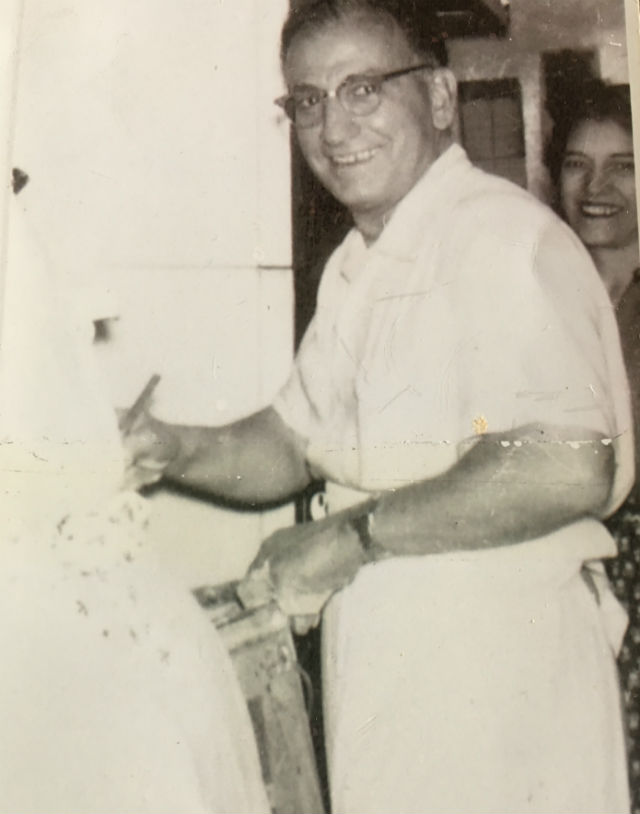

Frank Todaro says that his parents needed a break and this arrangement allowed them to spend some time with friends and family in Santo Stefano.
"They were working seven days a week, 10-15 hours a day in that restaurant," he remembers. "That’s why I say it’s easy to make a success in the restaurant business, all you have to do is work seven days a week, 16 hours a day. That’s what my mother and father did, and that’s why it was a success.
"Now my father was starting to slow down, getting tired and they more and more wanted to go back to Italy and spend time. In 1960 we went back and spent a whole year there. I was with them."
"I was only 11 years old at the time," remembers Mazza’s daughter Marie Schick. "We were just excited that my father was buying a pizza restaurant. We had no idea what was involved. And neither did he."
While Mazza and Todaro will still partners, they came upon the idea of selling frozen pizzas at the restaurant and a local grocery chain.
"A year or so after they got into business together," says Chuck Mazza, "they decided they’d make these seven-inch round par-baked frozen pizzas they would sell at Red Owl stores. Frank (Todaro) and I, our job in the summers was to make the pizzas. We’d make one to eat for breakfast and then we’d make 200 more and break for lunch. We’d eat another one for lunch and then go back and make another 200, 250 pizzas. I have made at last count 110,000 pizzas. Working like we did it doesn’t take long to get to 110,000 pizzas!
"I was a freshman in high school and Frank was a senior at the same school when my dad bought into the Caradaro Club. When Frank went off to college, I brought in four of my friends and we had an assembly line going. The only problem was we were so good my dad couldn’t sell the pizzas fast enough!"
Chuck Mazza has many fond memories of working, mainly in the kitchen, at the Caradaro Club. But he’s the first to say it wasn’t easy.
"Caradaro had a really good luncheon business. I went to Marquette University and my dad had a rule that I couldn’t take any 11 or 12 o’clock classes. I’d work lunch at Caradaro and run back to my 1 o’clock class. Sometimes I’d make the mistake of taking a date to the restaurant or going there after a game thinking we’d get a free pizza. My dad would say, ‘Chuck we’re really busy here, can you give us a hand?’ So, I’d be working while my friends were having a good time, (or my date) was waiting for me."
According to Jim Balistreri, who was hired by Mazza, "Joe Todaro, when he would come from Italy twice a year to collect money, would come in the kitchen and talk to me. He liked me. He knew that he was going to close the thing in Italy because of certain reasons over there. He knew when the lease was up he was going to take (Caradaro back) over.
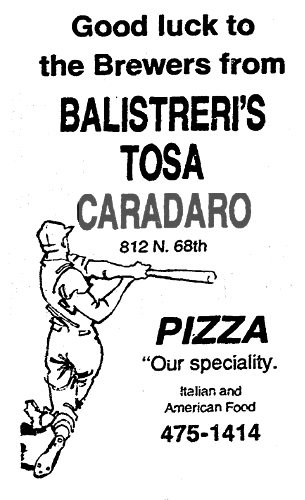

"So he got to know me, he could see how I worked. I was a worker. He came up to me every time he was here (and) said to me, ‘Jimmy when I take over the Caradaro Club I want you to stay here and I don’t know what your salary is, I really don’t care, but I’ll double it the very first hour you work for me.’ And I said ‘OK.’ Well he did, and within 2 or 3 years, he tripled it."
Chuck Mazza says that Todaro returned from Italy around 1966 and wanted to buy back into the business, though for whatever reason, Charlie Mazza wasn’t interested.
"So Joe said, ‘when the lease it up at the end of ‘67, you’re out," Chuck Mazza remembers.
And that’s exactly what happened. Todaro took over the Caradaro, and Mazza returned to accounting for a couple years, working at an area nursing home until his death in 1969.
When Balistreri decided to go into business for himself, it was natural that he’d keep it in the family. So he enlisted Mazza’s son, Chuck, and they opened four Caradaro Clubs.
"Both Joe and my dad had rights to the name," Chuck Mazza says, "but my dad didn’t do anything with it, so he handed it down to his children."
Chuck Mazza says that he and Balistreri opened their first Caradaro Club as a takeout-only place on 59th Street and Villard Avenue. That one lasted less than a year. But in ‘71, the duo opened two more almost simultaneously, at 68th and Wells Streets in Wauwatosa and at 49th and Burleigh Street.
"When Jimmy (Balistreri) opened up on 68th Street," says Bill Jennaro, "people lined up out on the street, waiting in line to get that pizza."
But things didn’t go as well up on Burleigh, Chuck Mazza recalls. Unable to get a liquor license, the place wilted and closed within a year or so. A location out on 159th Street and National Avenue in New Berlin suffered a similar fate.
"That place was bigger than a typical restaurant and there just weren’t enough people living around there at that time," says Mazza, and it, too, closed in less than two years.
Mazza at the time was employed full-time as a construction manager at Schlitz Brewery, where production was scaling back and he was tasked with converting former brewing space to more in-demand white collar office space. "Jim was running between the three places to keep them going. So we shuttered 49th and Burleigh and closed the one in New Berlin and Jim bought the one on 68th and Wells."
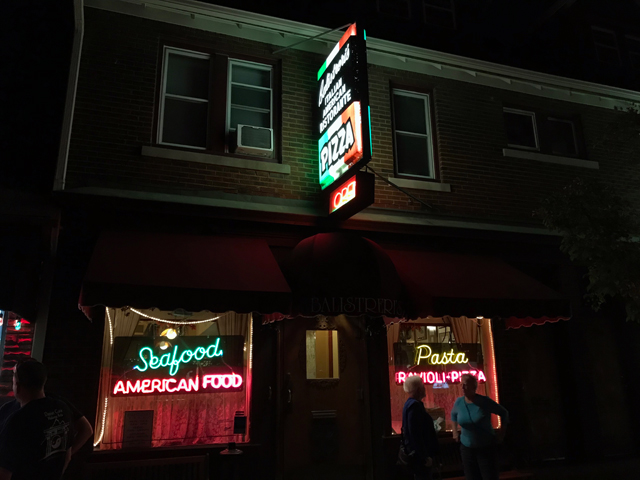

"(Chuck) became my friend because we’re the same age," Balistreri recalls. "And he and I opened a restaurant. His father was already out of business, because (Joe Todaro) had (returned) and taken over. So he and I started a business. We split up after a couple of years, and I stayed in business. He didn’t. I’m still friends with both families (Todaro and Mazza) today."
In 1965, Frank Todaro got out of the Army, spent a little time with his wife’s family in Tucson and then returned to Milwaukee and the Caradaro Club, to which his dad had returned and which his father had decided he wanted to sell.
"Now we’re talking about 1968," Frank says. "My mother had passed away (in autumn) and my father went into mourning for a year. But then he went out and about a year and a half later he met a lady (Eva Hedl Nettesheim, who he married in December 1969) at the Elks Club who was also a widow, and it was very nice. I was very happy for my father. He was pretty much retired, and so I ran the restaurant for a while, but I was getting very tired of it. It just wasn’t what I wanted to do with my life and so I ran away from home. I took me 'til I was 29 years old to run away from home (laughs).
"Now he’s got another wife and the two of them had savings, and I was gone. I was the eldest son, there was no reason for him to work that hard anymore. In retrospect, it was really a good thing. It all turned out well because I ended up here in Colorado, and I couldn’t be happier. My whole life was a lot different here than it was in Milwaukee and it suited me. I have nothing against Milwaukee or anything like that, but this happens to be where I wanted to be, that’s all."
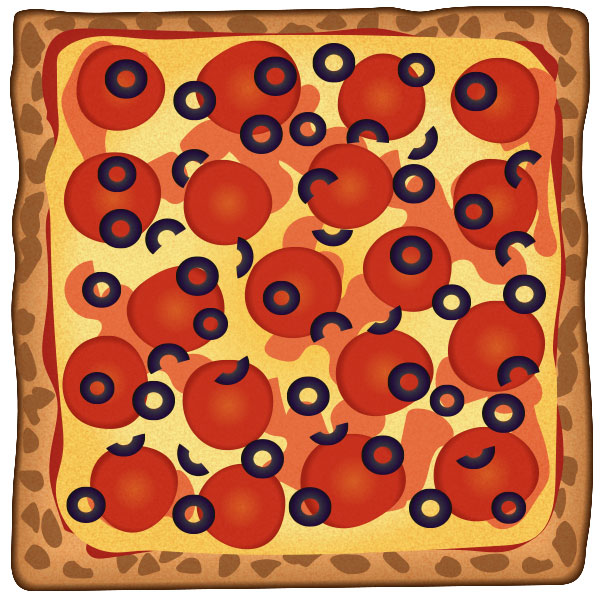
A new life for Caradaro
Upon Joe Todaro’s return from Sicily, he had hired Gino Pazzano, who became a trusted employee, according to his cousin, Calderone Club’s Gino Fazzari.
"Gino was here (from Italy) visiting my dad (Antonio), my mom and some other relatives," Fazzari recalls. "And he somehow stumbled onto the Caradaro Club in the Third Ward and he started going in there, and hanging out there, and he befriended the owner.
"Joe (Todaro) says, ‘We need some help. We need a pizza man. You want to give us hand?’ He goes, ‘OK.’ He had experience working in Italy. Joe absolutely falls in love with my cousin, and he takes my cousin Gino under his wing."
With Pazzano on board, the business was again running smoothly and so Todaro floated the idea of his young protege buying Caradaro Club.
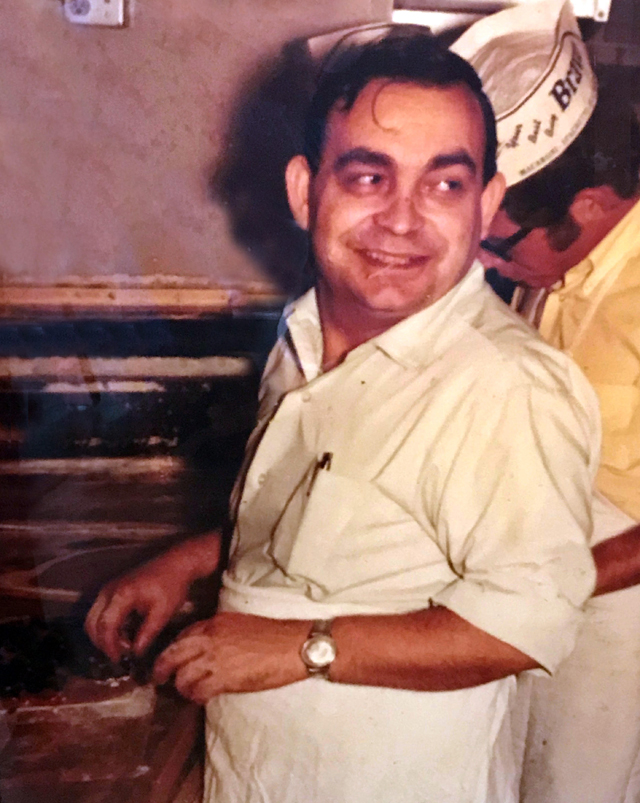

"'Why don’t you take the place over?' he says to Gino," says Fazzari. "My cousin was in his 20s, and he goes, 'How am I going to take it over? I've got no means'."
But Pazzano knew someone that did have the means: his uncle Antonio Fazzari, who had arrived from Italy a few years earlier and had run a tavern near Brady Street.
"So he calls my dad, and he says, ‘I told you about this place where I was working. They want to sell it.’ My dad was working at Pabst Brewery, driving a forklift. Then he was doing terrazzo flooring at night, and doing some other things. And so my dad comes and took the place, he meets with Joe, hey work out a land contract. My dad buys the Caradaro Club brand, the building (on a land contract) and the pizza restaurant. Joe showed my dad the recipe and so did Gino."
Fazzari and his family had lived above a small bar on the corner of Kane Place and Pulaski Street, near Wolski’s, Gino Fazzari remembers, and that’s where Antonio earned some hospitality experience.
"The bar (called Fazzari's Tap, at 1121 E. Kane Pl., now razed) was vacant, nobody wanted it, so my mom and dad were living upstairs, and my dad says to the landlord, ‘Well if you got nobody to take it, I’ll try it.’ It was a bar, no food. This was probably ‘66, ‘67.


"This was right across from Pfister and Vogel Tannery and a bunch of other companies. What my mom would do was make food and bring it down at lunch time, and put it on the bar. And the factory workers would come in. They’d go crazy, and they’d eat the food, (which) was free. But they’d buy the beer. The place started getting busier and busier and busier, and all these factory workers were spreading the word to come here, the food was free, you've just got to pay for the booze, you know?
"There was a line outside. The City of Milwaukee health inspector shows up and says, ‘You have food in here but you don’t have a food dealer’s license.’ He didn’t even have a kitchen. ‘How are you doing this food?’ So the guy is like, ‘I’ll give you a citation. We’ll put your liquor license in jeopardy, you’re selling this food without a food dealer’s license.’ My dad goes, ‘Well, it’s a good thing I don’t have a food dealer’s license, ‘cause I’m not selling the food. I’m giving the food away.’ Nobody’s paying for any of the food. Not a single receipt for food. So the guy didn’t know what to do. There is no law (being broken)."
By 1969, Tony Fazzari (pictured above in a photo taken at the Caradaro Club) was the new owner of the Caradaro Club, and it was not long afterward that Tosa Caradaro was renamed Balistreri’s Italian American Restaurant.
Fazzari’s tenure at Caradaro would prove to be short. In 1973, because the Fazzari family was moving back to Italy, Tony sold the business to his wife’s brothers Consiglio and Ilario Cirillo. Soon, Connie bought out Ilario and would own the business for many years.
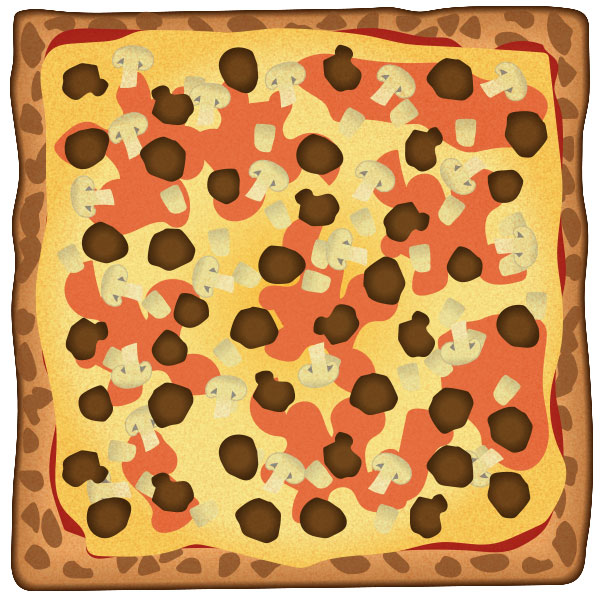
Caradaro in the ‘70s
Right around this time – in February 1973 – was when The Journal’s Gerald Kloss stopped in for a visit.
"The place looked about the same as it did two decades ago," he wrote. "Red front door. Gray slab battens on the front, aged red brick sides. A U-shaped, neighborhood tavern sized bar. A bowling machine where you slide pucks and make ridiculous scores. A back room with tables and the inevitable checkerboard tablecloths of red and white. And, of course, the head, steaming aroma of ensauced tomato and herbs."

Fire!
In September 1978, an overnight grease fire all but destroyed the Erie Street restaurant, the birthplace of Milwaukee pizza.
The fire had started in the kitchen around 3 a.m. and then engulfed the entire building. According to a Milwaukee Fire Department battalion chief on the scene, the roof and floors caved in and then "the walls caved out," damaging an adjacent industrial building.
City inspectors noted at the time that "a large section of roof and upper walls collapsed. The remainder of the interior walls, floors and ceilings are both fire and water damaged."
The building, they determined, was "unfit for occupancy and unreasonable to repair." A raze order was issued and on Feb. 8, 1979 the original Caradaro Club was gone, and so was a piece of Milwaukee dining and social history, one that had meant a lot to many people.
"There would be people that would come in there they were dating," says Frank Todaro. "There were a lot of marriage proposals and things like that and then 10-15 years later they’d come back (and say), ‘yeah he proposed to me right here.’That’s kind of how that building and the business was.
"My parents worked very hard for about 27 years. My father was very particular about how he made the pizza. To me that was the success of it."

What next?
Cirillo considered rebuilding – and even applied for a permit to do so – but later decided against it, reopening instead in Muskego. He sold that restaurant in 1983 and opened one in an old schoolhouse at 81st and National in May 1984. Tragically, that restaurant, too, was consumed by fire, the following June.
Two years later, Cirillo rebought and reopened the Muskego restaurant he’d sold for $325,000 (including the pizza recipe) in ‘83. Later, he opened a carry-out and delivery place on 70th and Greenfield.
The father of Milwaukee pizza, Joe Todaro, then living in Largo, Florida, died at age 74 on June 6, 1983. His Caradaro partner John Caravella had died in 1971. Both are buried at Holy Cross Cemetery on Milwaukee’s northwest side.
Frank Todaro moved out west to Colorado and for a few years he ran a pizzeria there, using the Caradaro recipe.
"We called it Theodaro’s because the name of the guy that I went into partnership with was Teddy, and so Theodore, cause I had to take the same idea of combining names as my father and (Caravella) did back then," Todaro says. "But, in those days I wasn’t in the right frame of mind to be a businessman. It lasted about two or three years, and then I got out of it."
When Cirillo wanted to retire, his daughter Francesca and son-in-law Rosario LoCicero took over for a while, but, in 2002, the business was sold to Wally Kutch, who added a new location on Vliet Street, which continues to operate today.

Caradaro Club’s pizza legacy
When you think of Milwaukee pizza – that flaky almost cracker-thin crust, on a rectangular pan, cut into squares – you’re thinking of Caradaro pizza, the legacy of which is served to Milwaukee pizza fans at a number of places around the city today.
Kutch follows the recipe at the current Caradaro and so does Balistreri at his two restaurants.
"That’s why I’m still in business," Balistreri says with a laugh. "Of course, that made us. I made the food as a cook (at Caradaro), and when I quit, (Joe Todaro) knew I was going to make the same pizzas. He didn’t care because he liked me."
Bill Jennaro adds, "Bobby Zaffiro worked at the Caradaro Club, and he learned to make pizza at the Caradaro Club," noting that Lisa’s on Oakland also serves a pizza very much like the ones he remembers from the Caradaro Club.
Kutch, however, told Edible Milwaukee that it’s possible his pizza (which, unlike the original Caradaro’s, is round) does not hew exactly to the Caravella and Todaro specifications:
"Kutch admits that while he received the recipe from Connie Cirillo when he bought the Caradaro Club from him," he told Rick Rodriguez, "it is possible that it might not be the exact recipe as the original since it has changed hands a few times."
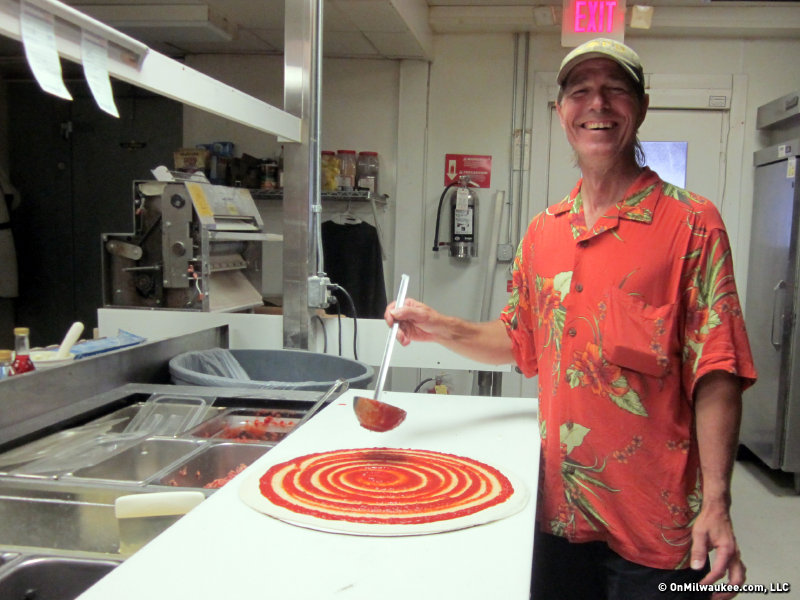

Gino Fazzari uses the original Caradaro recipe at Calderone Club.
When Tony Fazzari returned from Italy in 1976, he wanted to open his own place. "When we got back, he couldn’t use ‘Caradaro’(as a name) because he’d sold it to my uncle," the younger Fazzari remembers. "There was a restaurant in Italy called Il Calderone (The Cauldron). My dad loved the name, Calderone, and it sounds a little like Caradaro, so he opened up Calderone, adding ‘Club’ to the name to make it sound more like Caradaro Club.

A course-correction to preserve tradition
Gino Fazzari can relate to Kutch’s comment about how time can tinker a recipe off course. When Fazzari returned to Calderone Club after attending UW-Stout and the Culinary Institute of America, he noticed that the pizza he found wasn’t quite like the one he’d left seven years earlier.
"I came back, and I had a slice of pizza," he recalls, "and I said, ‘Dad, this isn’t your dough.’ Well, now he’s pissed off at me, right? ‘Joe College coming back, you think you know everything?’ I said, ‘No, Dad, but I’m telling you, I grew up on this pizza,’ and what happens is, if you eat it consistently and the changes are gradual, you don’t notice it."
As some products become unavailable, they have to be replaced. And new pizzaioli making the dough might forget a step or lack the same attention to detail as another. Passing along a recipe can be a lot like a game of telephone.
"My dad didn’t want to show everybody how to make it," Fazzari says. "He was making it for years. But then he’s got a new guy (in the kitchen), so he says, ‘Hey, I’m gonna show you the recipe, don’t show anybody else.’ That’s the deal. And then that guy would quit. Now you’ve got to train another guy, and so it starts to lose a little bit.
"I said ‘Dad, please, let’s go over this,' and so I pulled the kid (in the kitchen) over and said, ‘Show me how you’re making the dough.’The guy’s missed about five steps! He had combined stuff, missed stuff and I said, ‘Let me see the ingredients … this is not even the right flour!’ And so we had to reverse-engineer it. My dad and I did it together. I was very proud."
And Fazzari knows they got it right; that the pizza he’s making has the authentic Caradaro taste, because his uncle Connie Cirillo – who owned the Caradaro for years and passed away this past January – told him so.
"There was a little rift in the family, but my uncle came here, I would say probably (2003). He sat at the bar. He ordered a Junior Calderone Special, I’ll never forget, and I was so proud, because I got to make a pizza for my uncle.
"My uncle’s at the bar, he was eating the pizza, I went back to the kitchen, I came back, half the pizza’s gone. He said, ‘This is the original Caradaro Club pizza.’ He gave me a hug. He was very proud.
"Look, I’ve got goosebumps."
(NOTE: This post was updated to reflect new research in 2019 about Filippo Milone.)

